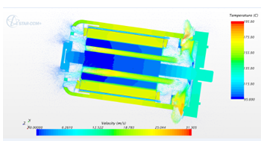Since version 2026, Flux 3D and Flux PEEC are no longer available.
Please use SimLab to create a new 3D project or to import an existing Flux 3D project.
Please use SimLab to create a new PEEC project (not possible to import an existing Flux PEEC project).
/!\ Documentation updates are in progress – some mentions of 3D may still appear.
Magneto-thermal coupling in Flux: in a few words
Definition
The magneto-thermal coupling means taking into account the interdependence between the electromagnetic and thermal phenomena. The software pieces mutually send the results to one another so that the interdependence can be taken into consideration for each simulation.
The needs
For electrical devices such as motors, the constraint over the reduction of the device size and the optimization of the device efficiency impose performing the study of the thermal phenomena in parallel to the electromagnetic study, as the two types of phenomena are interdependent.
The impact of the temperature field is notable on the losses. The temperature increase can have problematic consequences upon the device lifetime as a result of electrical insulation deterioration and on the magnets demagnetization, etc.
Moreover, the study of the thermal phenomena is frequently complex. For example, the modelling of the thermal exchanges at the air gap level during the motor operation and the evaluation of the thermal transfer coefficients require dedicated software for the computation of fluid flows and thermal transfers to fluids.
That is why the coupling between Flux, a dedicated software for the computation of electric and magnetic losses, and STAR-CCM+ or Fluent, dedicated programs for fluid dynamics and temperature computations, represent the best solution for optimizing the accuracy of these investigations.
STAR-CCM+ & Fluent
STAR-CCM+ is produced by Siemens company, and Fluent by Ansys, Inc.
They are both thermal modelling software of the CFD type ( computational fluid dynamics ).
The advantage of CFD investigations is the accurate evaluation of the device hot points, which is not possible with an analytical thermal tool that uses equivalent thermal circuits. They are able to model heat convective transfers and the fluid flows, giving a dedicated thermal environment for the choice of the cooling mode and of the input data on the thermal transfer coefficients by conduction, convection and radiation.
In those CFD software the thermal modelling is usually done in 3D, whereas electromagnetic studies can be done simply in 2D.


AcuSolve
AcuSolve is a CFD generalist solver from Altair. Contrary to other CFD tools, AcuSolve is based on finite elements method, which allows it to be strongly linked to other FEA technologies (Finite Element Analysis) to solve fluid-structure complex interactions and multiphysics problems, as Flux for example.
To answer to magneto-thermal coupling needs, mentioned previously, a strong coupling / cosimulation between Flux and AcuSolve is currently in progress.
In the meantime, it is possible now in Flux to export data readable by AcuSolve.
Setting up of the couplings
- The coupling Flux-STAR-CCM+ has been developed as a result of a close collaboration between the teams working on both software. This has resulted in the construction of dedicated interfaces, easy to operate by the user.
- The coupling Flux-Fluent has been set up using the existing functionalities in Fluent for the data exchange. Therefore, no dedicated interface has been made. The user needs advanced computer science knowledge to activate the communication between the two programs.
Coupling : Flux magnetic-Flux thermal
It is also possible to couple magnetic Flux project with thermal Flux project, thanks to the same method used for STAR-CCM+ and Fluent coupling.
In the previous Flux versions, this coupling was possible through python scripts. Now it works by entering the data in Flux dialog boxes, and thanks to the new exchange method which is completely automated.
This magneto-thermal coupling is accessible for the following modules:
- 2D
- 3D